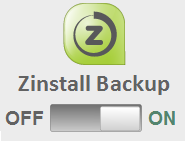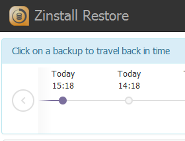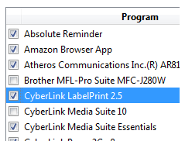In this article, we’ll learn how to backup Windows 10.
Our goal is to have an easy to setup backup software, that will back up Windows 10 program files, apps, settings, profiles, emails, accounts, passwords, documents, pictures, music – everything you’ve got.
Of course, we want our Windows 10 backup to be automatic, so that it keeps itself always up to date without the user manually doing anything.
And, as in any backup solution, the main goals not the backup – the goal is to be able to actually restore your stuff, in case of a disaster or in case of just accidentally deleting an important file.
You can sign up for a free 30-day trial of the backup product here:
30-day trial of Zinstall FullBack.
USB drive (external hard drive / backup drive): the simplest way to store your backup is to keep it on a USB drive connected to the computer. USB external hard drives are cheap, have lots of storage space and are available in any store. All you need to do is connect the drive to your Windows 10 computer, and run Zinstall FullBack. It will detect a USB drive automatically and start using it as the backup destination (see instructions below).
Network drive (personal Cloud / Home Server / SAN / NAS): for more advanced users, a network drive may be a more convenient option. Similar to a USB drive, it offers a large amount of storage on the cheap. Its major advantage over a USB drive is that a network drive is not physically connected to the computer. You don’t have to have a physical device plugged in, and will never forget to connect it. To set a network drive as the destination for Zinstall FullBack, you just select it in Settings – see below.
Cloud storage (Dropbox / OneDrive / Google Drive): the next step from a network drive is Cloud storage. Its major advantage, from the backup perspective, is that Cloud storage is by definition off-site. This means that if disaster strikes, a house burns down, gets flooded etc. – Cloud storage still survives and will still be available to restore from. The disadvantage is that Cloud storage tends to be slow (especially for large volumes of data, such as a backup), and expensive.
Other storage options: additional storage options may include a smaller SD card or a USB stick connected to the computer (if you don’t have a lot of files to backup), dedicated backup media devices, etc. You can contact us for questions on those!
OK. Now that you have selected where you will keep your Windows 10 backup, let’s see how to actually set it up:

So what happens now? Zinstall FullBack will first make a full backup of your entire Windows 10. It means every file, every program, every setting you have there – all backed up and protected.
After that, it will keep backing up the changes on your every hour. So if you change a file, or install a new program, your backup will be updated accordingly within 60 minutes. This is all done completely automatically. In fact, you probably won’t even feel it running. It is very efficient in handling just the changes made, and even protects the hard drive’s health, by minimizing the amount of reads and writes to it (this makes the drive live longer!)
If you need to disconnect the drive for a while, it’s OK – Zinstall will patiently wait until you connect it again and continue backing everything up, automatically.
Of course, the real reason you have a backup is the restore part. How do you restore a single file that you’ve misplaced? And how do you restore everything, including program files, if your computer crashes? Read on to find out.
So you were working on an important document, and now it’s gone. Fear not – that’s exactly why you have set up an automatic backup of your entire Windows 10! Here is what you do:

That’s it – your file is back and unharmed.
This is something you can only do if you have used Zinstall FullBack. It can actually restore all the stuff from your backed up computer (programs, settings, files, emails, accounts, password, favorites, documents, pictures, music, etc.) onto a completely different computer and completely different Windows. Even if you’ve backed up a Windows 7 32bit Dell, and your replacement PC is a Windows 10 64bit HP, Zinstall will still restore everything you’ve got.

To do that, connect your backup storage to the new computer, and run Zinstall Rescue Kit on the new PC. When prompted, tell it to migrate from the backup container on the backup, and let it complete the restore. When finished, just restart the computer, and you’ll see all the programs, settings and files from your crashed computer.
Recently, a new type of virus has surfaced – ransomware. It encrypts all files on a computer, and demands money to give them back. A unique property of ransomware viruses is that they attack backups as well. They will seek out and encrypt Dropbox, OneDrive, USB hardware etc.
To protect your backup from ransomware attacks, Zinstall FullBack uses a unique SecureZone technology, which acts as total block from ransomware attacks. It simply does not allow any application – which is not Zinstall FullBack itself – to change the backup files. So when the ransomware virus attempts to encrypt them, it will fail to do so (although it will think that it hasn’t).
This means that in the event of a ransomware attack, your Zinstall FullBack will keep your files, settings and programs safely protected.
All you need to do is simply reset the infected computer to factory settings (in Windows 10, it is done with just a couple of clicks in using the Reset function), and restore your stuff back from Zinstall FullBack.
Yes, Zinstall FullBack is not the only option out there (although we believe it is the most effective). Here are some other ways you can handle your backup:
If you’ve ever experienced a computer crash or data loss (hopefully not first hand), you know how it feels. Out of nowhere, your files are gone, your programs are gone, your settings are gone. In fact, there is no way to prevent a disaster like that. It will happen, eventually.
But you can be ready for it.
As they say, the best way to do a backup is yesterday. The second best day is today.
If you have no backup at all, and don’t want to purchase one, at least copy your important files to a USB stick or another computer, and do it now.
If you are looking for a proper backup solution, that will backup everything on your Windows 10, to backup programs, settings, files and all the rest on your computer, Zinstall FullBack is the best choice for it.
It is complete, automatic (and always up to date), efficient, does not slow down your computer, preserves your hard drive – and most importantly, it will restore your files, and your programs, when you need them.